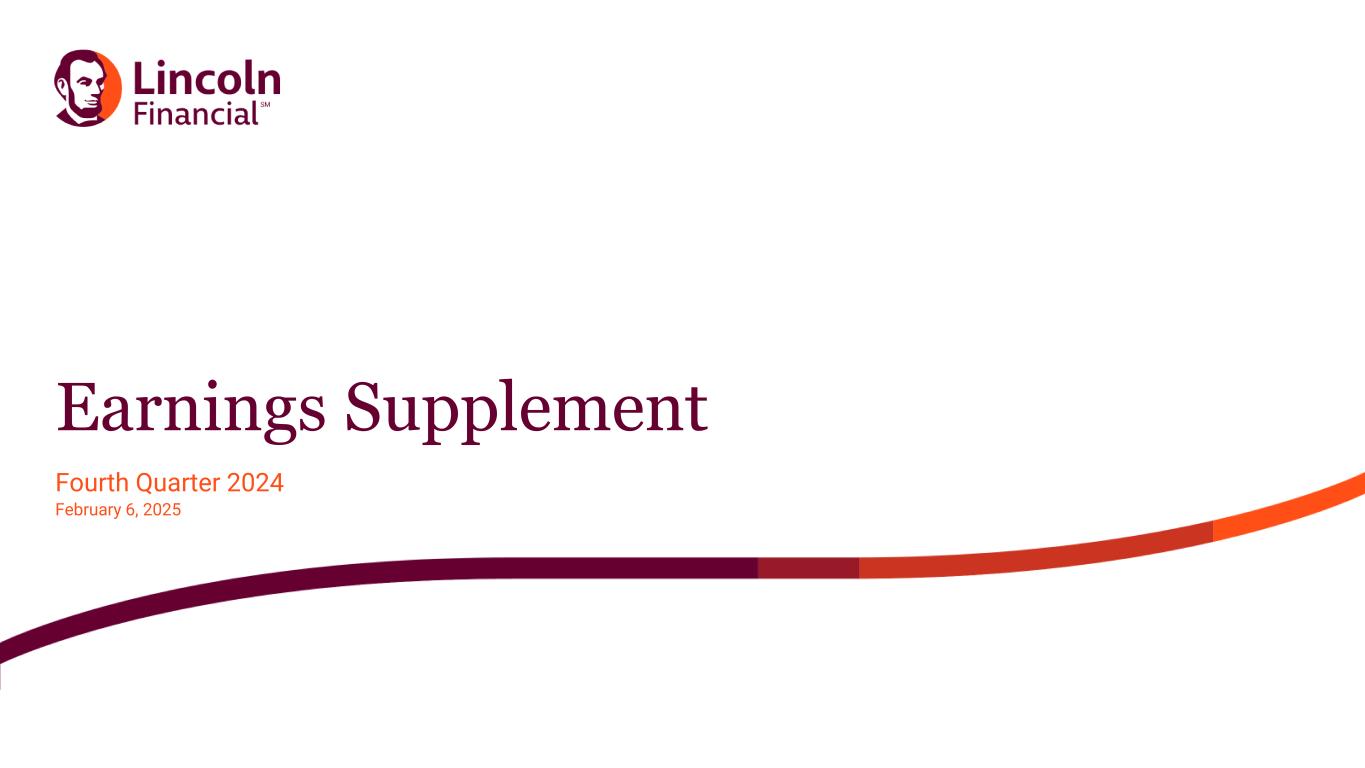
Earnings Supplement Fourth Quarter 2024 February 6, 2025
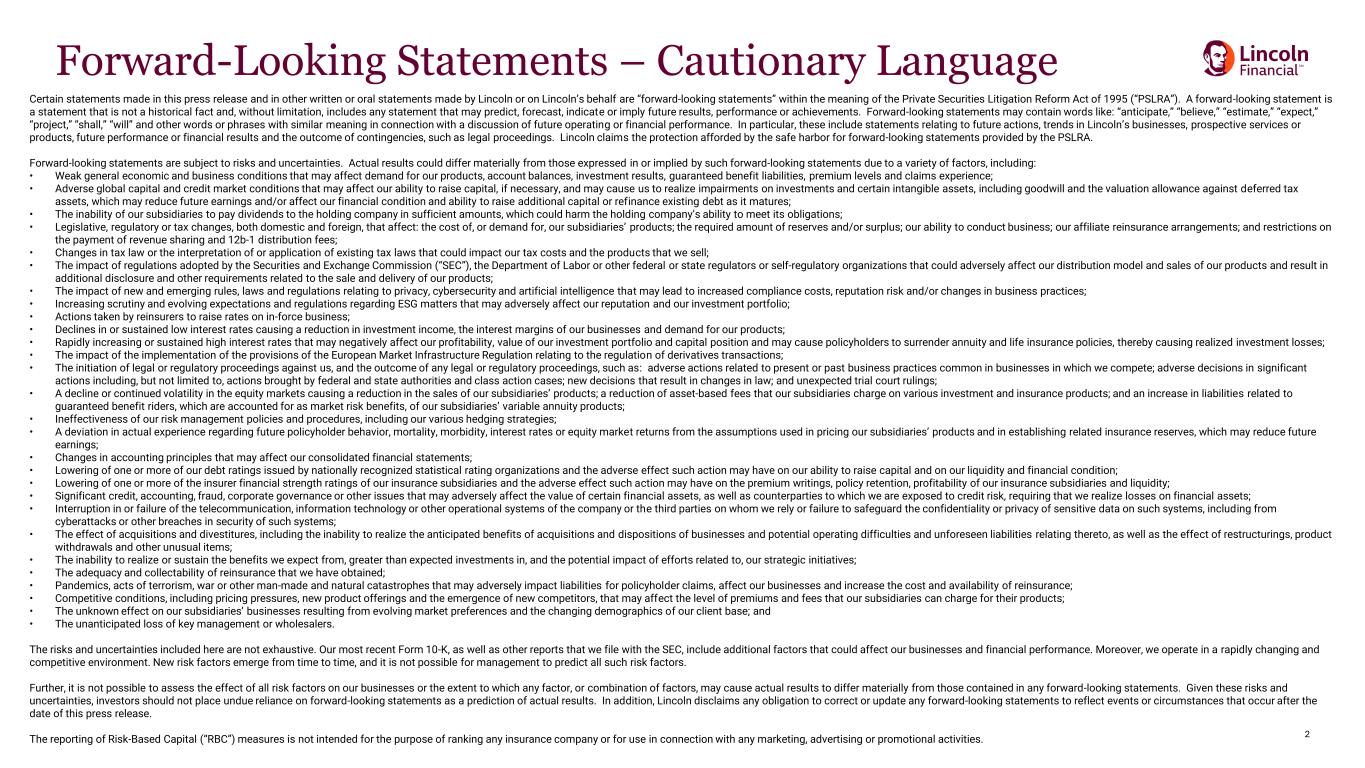
2 Forward-Looking Statements – Cautionary Language Certain statements made in this press release and in other written or oral statements made by Lincoln or on Lincoln’s behalf are “forward-looking statements” within the meaning of the Private Securities Litigation Reform Act of 1995 (“PSLRA”). A forward-looking statement is a statement that is not a historical fact and, without limitation, includes any statement that may predict, forecast, indicate or imply future results, performance or achievements. Forward-looking statements may contain words like: “anticipate,” “believe,” “estimate,” “expect,” “project,” “shall,” “will” and other words or phrases with similar meaning in connection with a discussion of future operating or financial performance. In particular, these include statements relating to future actions, trends in Lincoln’s businesses, prospective services or products, future performance or financial results and the outcome of contingencies, such as legal proceedings. Lincoln claims the protection afforded by the safe harbor for forward-looking statements provided by the PSLRA. Forward-looking statements are subject to risks and uncertainties. Actual results could differ materially from those expressed in or implied by such forward-looking statements due to a variety of factors, including: • Weak general economic and business conditions that may affect demand for our products, account balances, investment results, guaranteed benefit liabilities, premium levels and claims experience; • Adverse global capital and credit market conditions that may affect our ability to raise capital, if necessary, and may cause us to realize impairments on investments and certain intangible assets, including goodwill and the valuation allowance against deferred tax assets, which may reduce future earnings and/or affect our financial condition and ability to raise additional capital or refinance existing debt as it matures; • The inability of our subsidiaries to pay dividends to the holding company in sufficient amounts, which could harm the holding company’s ability to meet its obligations; • Legislative, regulatory or tax changes, both domestic and foreign, that affect: the cost of, or demand for, our subsidiaries’ products; the required amount of reserves and/or surplus; our ability to conduct business; our affiliate reinsurance arrangements; and restrictions on the payment of revenue sharing and 12b-1 distribution fees; • Changes in tax law or the interpretation of or application of existing tax laws that could impact our tax costs and the products that we sell; • The impact of regulations adopted by the Securities and Exchange Commission (“SEC”), the Department of Labor or other federal or state regulators or self-regulatory organizations that could adversely affect our distribution model and sales of our products and result in additional disclosure and other requirements related to the sale and delivery of our products; • The impact of new and emerging rules, laws and regulations relating to privacy, cybersecurity and artificial intelligence that may lead to increased compliance costs, reputation risk and/or changes in business practices; • Increasing scrutiny and evolving expectations and regulations regarding ESG matters that may adversely affect our reputation and our investment portfolio; • Actions taken by reinsurers to raise rates on in-force business; • Declines in or sustained low interest rates causing a reduction in investment income, the interest margins of our businesses and demand for our products; • Rapidly increasing or sustained high interest rates that may negatively affect our profitability, value of our investment portfolio and capital position and may cause policyholders to surrender annuity and life insurance policies, thereby causing realized investment losses; • The impact of the implementation of the provisions of the European Market Infrastructure Regulation relating to the regulation of derivatives transactions; • The initiation of legal or regulatory proceedings against us, and the outcome of any legal or regulatory proceedings, such as: adverse actions related to present or past business practices common in businesses in which we compete; adverse decisions in significant actions including, but not limited to, actions brought by federal and state authorities and class action cases; new decisions that result in changes in law; and unexpected trial court rulings; • A decline or continued volatility in the equity markets causing a reduction in the sales of our subsidiaries’ products; a reduction of asset-based fees that our subsidiaries charge on various investment and insurance products; and an increase in liabilities related to guaranteed benefit riders, which are accounted for as market risk benefits, of our subsidiaries’ variable annuity products; • Ineffectiveness of our risk management policies and procedures, including our various hedging strategies; • A deviation in actual experience regarding future policyholder behavior, mortality, morbidity, interest rates or equity market returns from the assumptions used in pricing our subsidiaries’ products and in establishing related insurance reserves, which may reduce future earnings; • Changes in accounting principles that may affect our consolidated financial statements; • Lowering of one or more of our debt ratings issued by nationally recognized statistical rating organizations and the adverse effect such action may have on our ability to raise capital and on our liquidity and financial condition; • Lowering of one or more of the insurer financial strength ratings of our insurance subsidiaries and the adverse effect such action may have on the premium writings, policy retention, profitability of our insurance subsidiaries and liquidity; • Significant credit, accounting, fraud, corporate governance or other issues that may adversely affect the value of certain financial assets, as well as counterparties to which we are exposed to credit risk, requiring that we realize losses on financial assets; • Interruption in or failure of the telecommunication, information technology or other operational systems of the company or the third parties on whom we rely or failure to safeguard the confidentiality or privacy of sensitive data on such systems, including from cyberattacks or other breaches in security of such systems; • The effect of acquisitions and divestitures, including the inability to realize the anticipated benefits of acquisitions and dispositions of businesses and potential operating difficulties and unforeseen liabilities relating thereto, as well as the effect of restructurings, product withdrawals and other unusual items; • The inability to realize or sustain the benefits we expect from, greater than expected investments in, and the potential impact of efforts related to, our strategic initiatives; • The adequacy and collectability of reinsurance that we have obtained; • Pandemics, acts of terrorism, war or other man-made and natural catastrophes that may adversely impact liabilities for policyholder claims, affect our businesses and increase the cost and availability of reinsurance; • Competitive conditions, including pricing pressures, new product offerings and the emergence of new competitors, that may affect the level of premiums and fees that our subsidiaries can charge for their products; • The unknown effect on our subsidiaries’ businesses resulting from evolving market preferences and the changing demographics of our client base; and • The unanticipated loss of key management or wholesalers. The risks and uncertainties included here are not exhaustive. Our most recent Form 10-K, as well as other reports that we file with the SEC, include additional factors that could affect our businesses and financial performance. Moreover, we operate in a rapidly changing and competitive environment. New risk factors emerge from time to time, and it is not possible for management to predict all such risk factors. Further, it is not possible to assess the effect of all risk factors on our businesses or the extent to which any factor, or combination of factors, may cause actual results to differ materially from those contained in any forward-looking statements. Given these risks and uncertainties, investors should not place undue reliance on forward-looking statements as a prediction of actual results. In addition, Lincoln disclaims any obligation to correct or update any forward-looking statements to reflect events or circumstances that occur after the date of this press release. The reporting of Risk-Based Capital (“RBC”) measures is not intended for the purpose of ranking any insurance company or for use in connection with any marketing, advertising or promotional activities.

3 Outlook
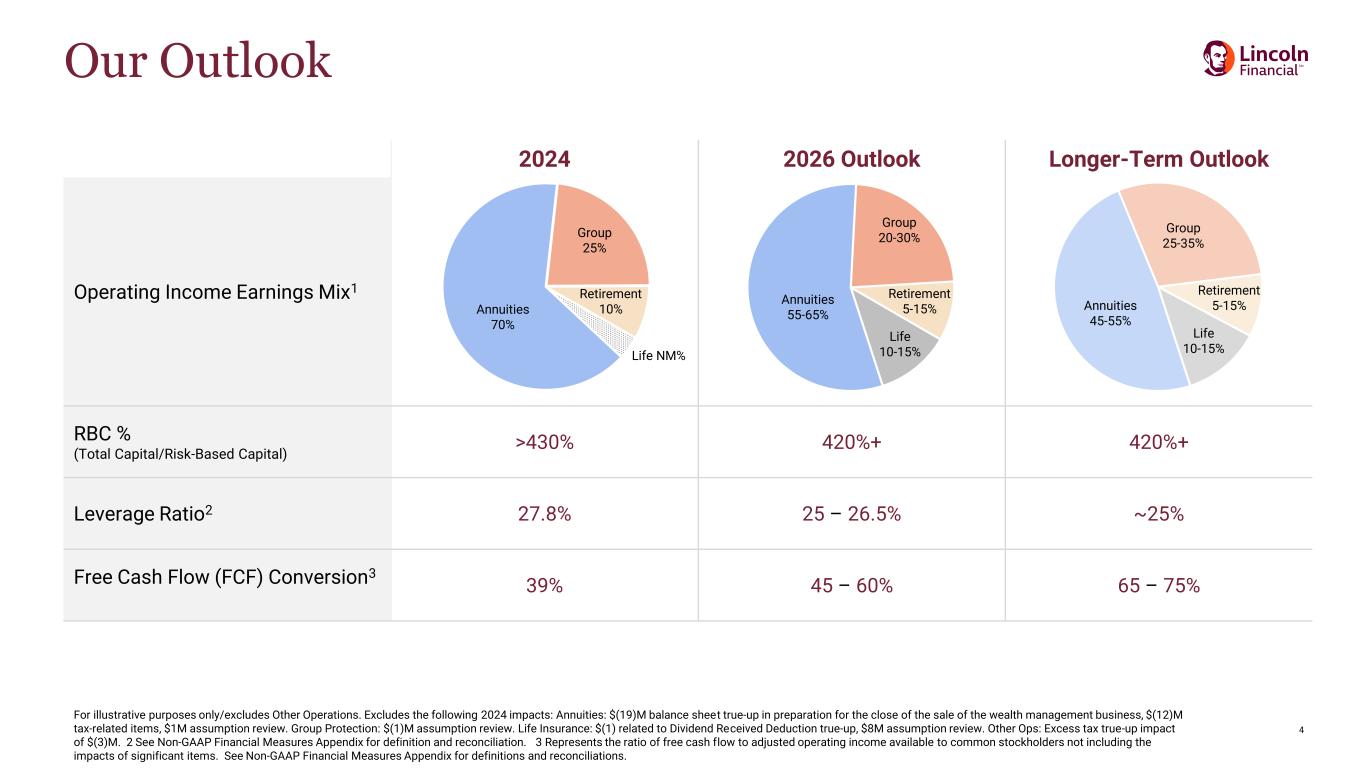
4 Our Outlook 2024 2026 Outlook Longer-Term Outlook Operating Income Earnings Mix1 RBC % (Total Capital/Risk-Based Capital) >430% 420%+ 420%+ Leverage Ratio2 27.8% 25 – 26.5% ~25% Free Cash Flow (FCF) Conversion3 39% 45 – 60% 65 – 75% Annuities 70% Group 25% Retirement 10% Life NM% Annuities 55-65% Group 20-30% Retirement 5-15% Life 10-15% Annuities 45-55% Group 25-35% Retirement 5-15% Life 10-15% For illustrative purposes only/excludes Other Operations. Excludes the following 2024 impacts: Annuities: $(19)M balance sheet true-up in preparation for the close of the sale of the wealth management business, $(12)M tax-related items, $1M assumption review. Group Protection: $(1)M assumption review. Life Insurance: $(1) related to Dividend Received Deduction true-up, $8M assumption review. Other Ops: Excess tax true-up impact of $(3)M. 2 See Non-GAAP Financial Measures Appendix for definition and reconciliation. 3 Represents the ratio of free cash flow to adjusted operating income available to common stockholders not including the impacts of significant items. See Non-GAAP Financial Measures Appendix for definitions and reconciliations.
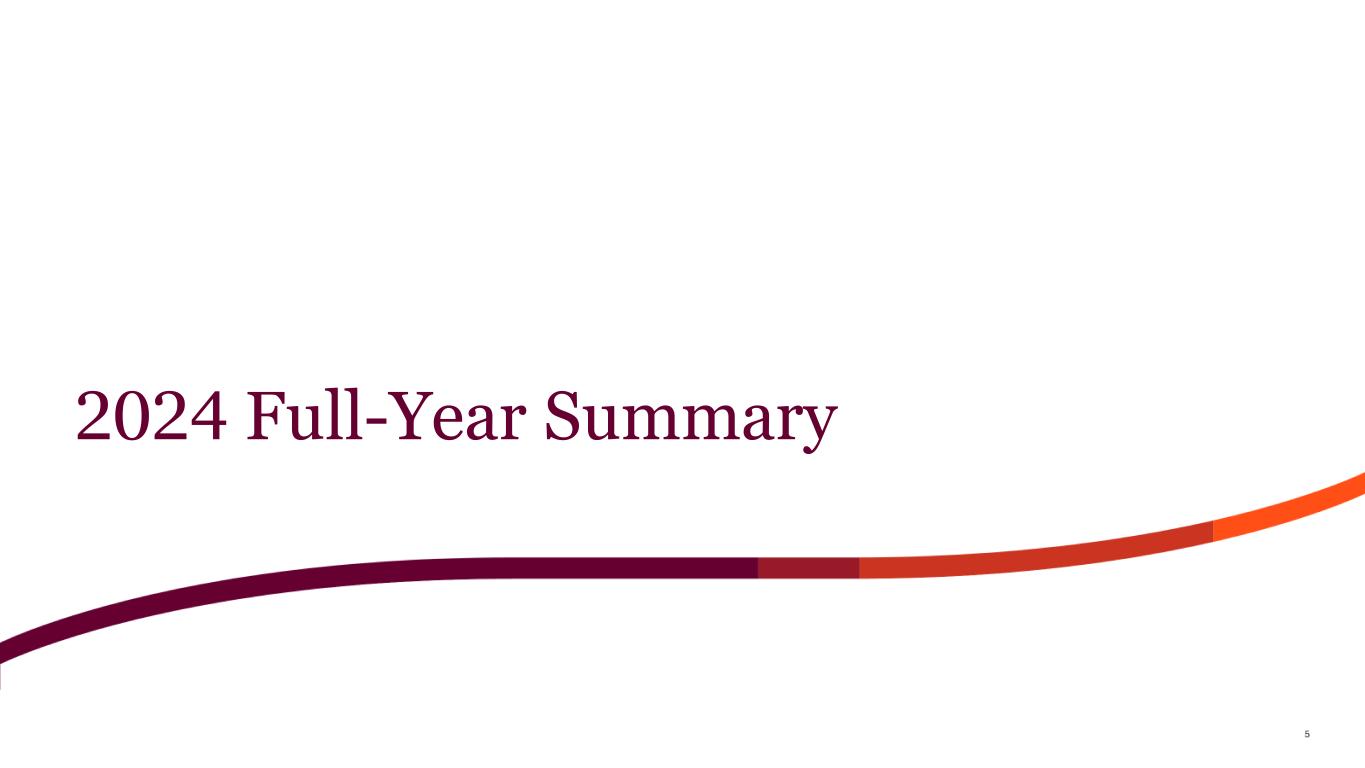
5 2024 Full-Year Summary

6 1 The RBC ratio is calculated as of December 31 annually, but is reported in the March statutory reporting, and as such, the ratio presented is considered an estimate based on information known at the time of reporting. 2 Represents Adjusted Operating Income Available to Common Stockholders, excluding significant Items. See Non-GAAP Financial Measures Appendix for definition and reconciliations. 3 See Non-GAAP Financial Measures Appendix for definition and reconciliation. 4 Excludes the following impacts: 3Q23 $24M assumption review and 3Q24 $(1)M assumption review. 5 Excludes the following impacts: 2023: $11 related to Dividend Received Deduction true-up $(12)M assumption review, model refinement of $14M. Annuities 2024: $(19)M balance sheet true-up in preparation for the close of the sale of the wealth management business, $(12)M tax-related items, $1M assumption review. 2024 Scorecard 27.8% 240bp YOY reduction in leverage ratio3 8.3% ~280bp improvement in Group Protection full-year operating margin4 $312B 7% YOY growth in average account balances, net of reinsurance $1.3B2 +18% increase in adjusted operating income YOY2 >430%1 RBC Ratio, >30 bps above target $13.7B Full-year Annuities sales, highest since 2019 supported by a diversified product mix Build Foundational Capital • Sustained RBC above 420% buffer for three consecutive quarters. • Sold wealth management business, generating ~$650 million net statutory capital benefit. • Repaid $100 million in debt and pre-funded $300 million 2025 debt maturity. Optimize Operating Model • Established LPINE, a Bermuda-based affiliated reinsurer, and executed in-force transactions. • Reduced operating costs and increased organizational efficiency while targeting investments to drive future profitable growth. • Ongoing optimization of our investment strategy through enhanced strategic asset allocation. Drive Profitable Growth • Group Protection delivered its highest ever operating income, sales, and operating margin in FY 2024. • Annuities FY operating income grew by 12% YOY5 and Retirement Plan Services delivered stable earnings. • The Life Insurance business made significant progress, evolving its product focus and distribution approach to support future profitable growth.
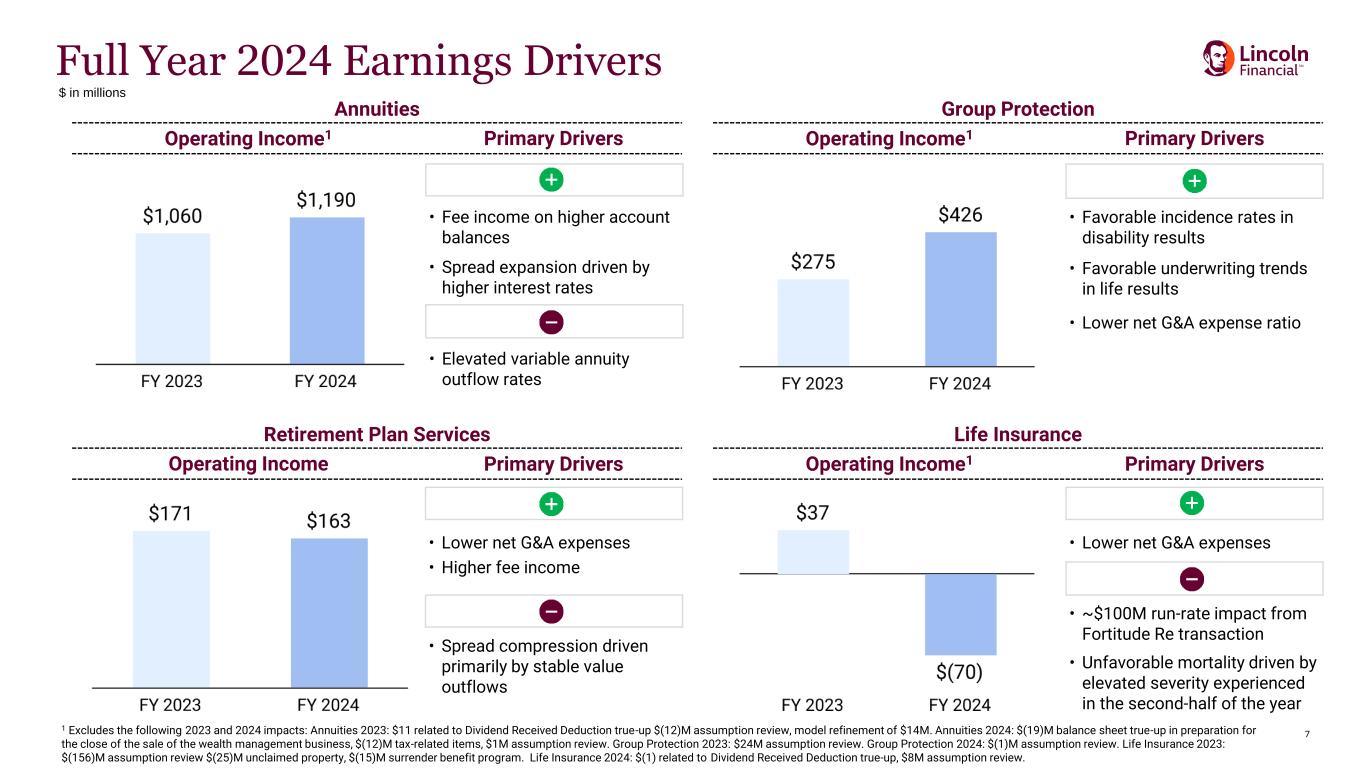
7 1 Excludes the following 2023 and 2024 impacts: Annuities 2023: $11 related to Dividend Received Deduction true-up $(12)M assumption review, model refinement of $14M. Annuities 2024: $(19)M balance sheet true-up in preparation for the close of the sale of the wealth management business, $(12)M tax-related items, $1M assumption review. Group Protection 2023: $24M assumption review. Group Protection 2024: $(1)M assumption review. Life Insurance 2023: $(156)M assumption review $(25)M unclaimed property, $(15)M surrender benefit program. Life Insurance 2024: $(1) related to Dividend Received Deduction true-up, $8M assumption review. Annuities Group Protection Operating Income1 Primary Drivers Operating Income1 Primary Drivers Retirement Plan Services Life Insurance Operating Income Primary Drivers Operating Income1 Primary Drivers Full Year 2024 Earnings Drivers $ in millions • Fee income on higher account balances • Spread expansion driven by higher interest rates • Elevated variable annuity outflow rates • Lower net G&A expenses • Higher fee income • Spread compression driven primarily by stable value outflows • Lower net G&A expenses • ~$100M run-rate impact from Fortitude Re transaction • Unfavorable mortality driven by elevated severity experienced in the second-half of the year • Favorable incidence rates in disability results • Favorable underwriting trends in life results • Lower net G&A expense ratio
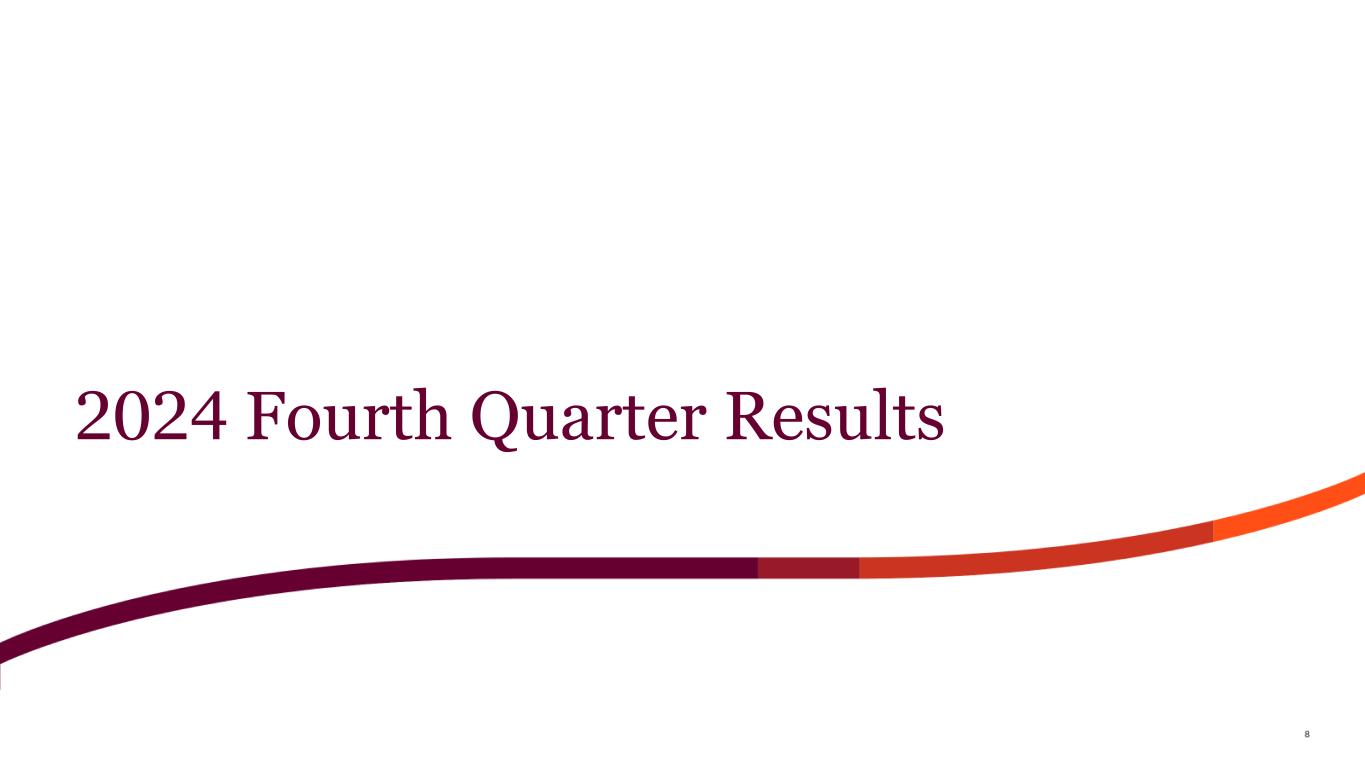
8 2024 Fourth Quarter Results

9 Strong earnings growth, driven by strategic initiatives to enhance profitability • Adjusted operating income, excluding significant items1, increased 39% YOY, reflecting accelerated momentum and broad-based execution. • Group Protection earnings more than doubled YOY to a new 4Q record; margin was 8.3%, up 430 bps YOY. • Annuities and Retirement Plan Services (RPS) generated YOY earnings growth of 14%2 and 13%, respectively. Successful execution of market segment and product mix strategies is accelerating sales • Group Protection generated record sales with growth across all product lines. • Annuities 4Q sales rounded out a strong year in which full-year sales reached the highest level since 2019, supported by a diversified product mix. • RPS total deposits increased 17% YOY as first-year sales grew 46%, and Life Insurance sales were essentially unchanged sequentially as we continued to focus on growth in products with more risk sharing. Year-end RBC ratio4 highest in 4 years, creating flexibility to continue investing in growth • Ended 2024 with estimated RBC ratio of >430% as capital position continued to strengthen. • Leverage ratio5 declined 240 bps YOY to 27.8%, driven by continued organic equity growth. • Expense discipline and operational efficiencies further enhanced operating leverage. After- tax Per share Adjusted Operating Income, ex. normalizing items $324M $1.86 Normalizing items Alternative investment income compared to our 10% long-term return target $8M $0.05 Total items impact $8M $0.05 Adjusted Operating Income3 $332M $1.91 4Q24 Key Messages 1 Represents Adjusted Operating Income Available to Common Stockholders, excluding significant items. See Non-GAAP Financial Measures Appendix for definition and reconciliations. 2 Excludes the impact of the 4Q23 $14M model refinement. 3 Represents Adjusted Operating Income Available to Common Stockholders. See Non-GAAP Financial Measures Appendix for definition and reconciliation. 4 The RBC ratio is calculated as of December 31 annually, but is reported in the March statutory reporting, and as such, the ratio presented is considered an estimate based on information known at the time of reporting. 5 See Non-GAAP Financial Measures Appendix for definition and reconciliations.
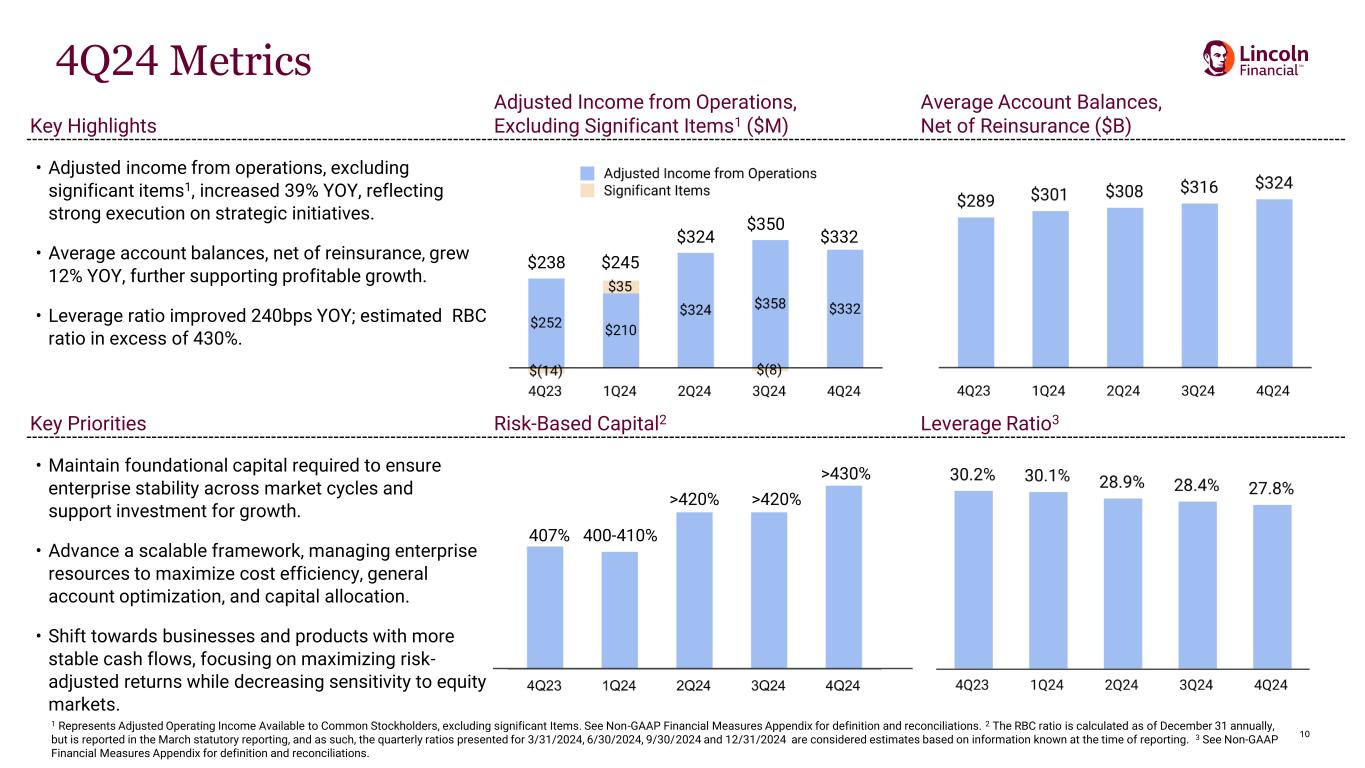
10 Key Highlights Adjusted Income from Operations, Excluding Significant Items1 ($M) Average Account Balances, Net of Reinsurance ($B) • Adjusted income from operations, excluding significant items1, increased 39% YOY, reflecting strong execution on strategic initiatives. • Average account balances, net of reinsurance, grew 12% YOY, further supporting profitable growth. • Leverage ratio improved 240bps YOY; estimated RBC ratio in excess of 430%. Key Priorities Risk-Based Capital2 Leverage Ratio3 • Maintain foundational capital required to ensure enterprise stability across market cycles and support investment for growth. • Advance a scalable framework, managing enterprise resources to maximize cost efficiency, general account optimization, and capital allocation. • Shift towards businesses and products with more stable cash flows, focusing on maximizing risk- adjusted returns while decreasing sensitivity to equity markets. 4Q24 Metrics $238 $245 $324 $350 407% 400-410% >420% >420% $332 >430% 1 Represents Adjusted Operating Income Available to Common Stockholders, excluding significant Items. See Non-GAAP Financial Measures Appendix for definition and reconciliations. 2 The RBC ratio is calculated as of December 31 annually, but is reported in the March statutory reporting, and as such, the quarterly ratios presented for 3/31/2024, 6/30/2024, 9/30/2024 and 12/31/2024 are considered estimates based on information known at the time of reporting. 3 See Non-GAAP Financial Measures Appendix for definition and reconciliations.
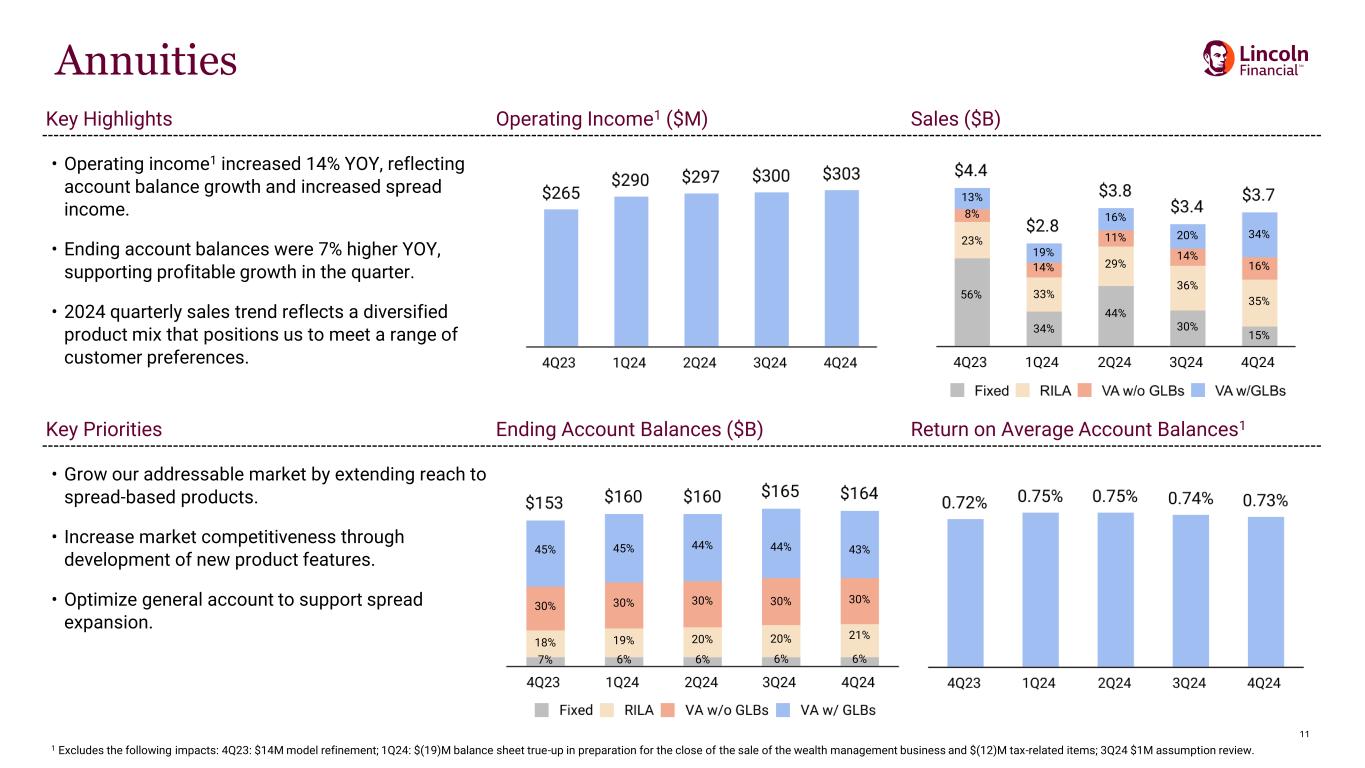
11 Key Highlights Operating Income1 ($M) Sales ($B) • Operating income1 increased 14% YOY, reflecting account balance growth and increased spread income. • Ending account balances were 7% higher YOY, supporting profitable growth in the quarter. • 2024 quarterly sales trend reflects a diversified product mix that positions us to meet a range of customer preferences. Key Priorities Ending Account Balances ($B) Return on Average Account Balances1 • Grow our addressable market by extending reach to spread-based products. • Increase market competitiveness through development of new product features. • Optimize general account to support spread expansion. Annuities 1 Excludes the following impacts: 4Q23: $14M model refinement; 1Q24: $(19)M balance sheet true-up in preparation for the close of the sale of the wealth management business and $(12)M tax-related items; 3Q24 $1M assumption review. 13% 8% 23% 56% 19% 14% 33% 34% 16% 11% 29% 44% 20% 14% 36% 30% 45% 30% 18% 7% 43% 30% 21% 6% 15% 35% 16% 34% 45% 30% 19% 6% 44% 30% 20% 6% 44% 30% 20% 6%
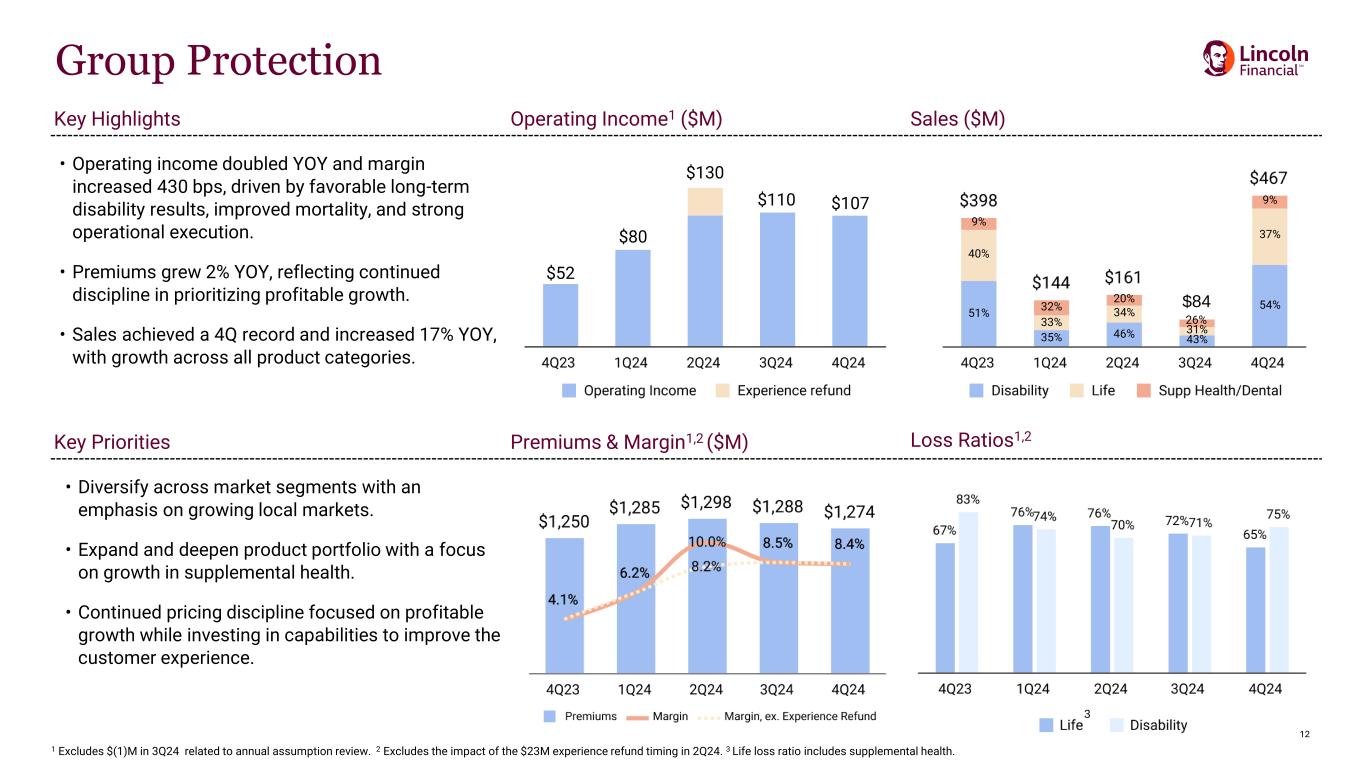
12 Key Highlights Operating Income1 ($M) Sales ($M) • Operating income doubled YOY and margin increased 430 bps, driven by favorable long-term disability results, improved mortality, and strong operational execution. • Premiums grew 2% YOY, reflecting continued discipline in prioritizing profitable growth. • Sales achieved a 4Q record and increased 17% YOY, with growth across all product categories. Key Priorities Premiums & Margin1,2 ($M) Loss Ratios1,2 • Diversify across market segments with an emphasis on growing local markets. • Expand and deepen product portfolio with a focus on growth in supplemental health. • Continued pricing discipline focused on profitable growth while investing in capabilities to improve the customer experience. Group Protection 1 Excludes $(1)M in 3Q24 related to annual assumption review. 2 Excludes the impact of the $23M experience refund timing in 2Q24. 3 Life loss ratio includes supplemental health. 40% 51% 9% 33% 32% 35% 20% 34% 46% 31% 9% 43% 37% 54% $52 $80 $130 $110 $107 3 $84 26%
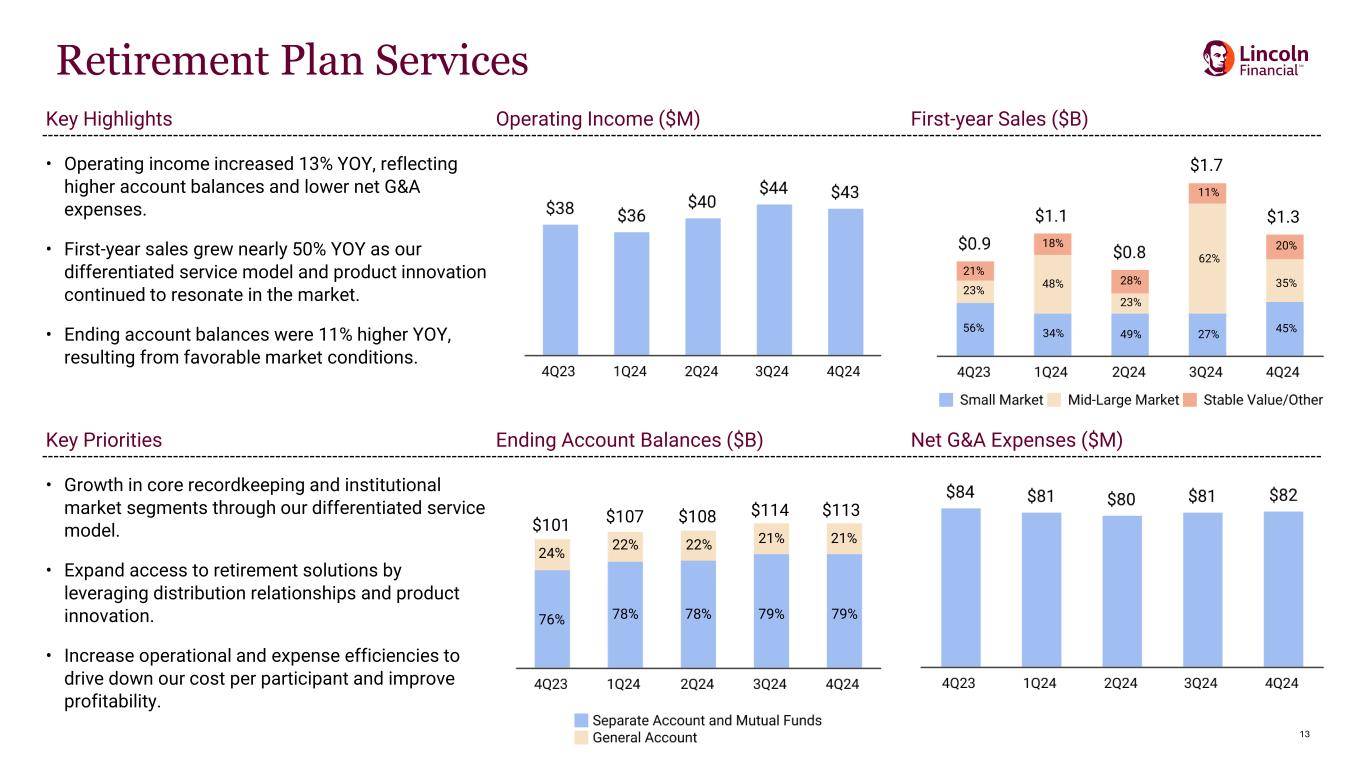
13 Key Highlights Operating Income ($M) First-year Sales ($B) • Operating income increased 13% YOY, reflecting higher account balances and lower net G&A expenses. • First-year sales grew nearly 50% YOY as our differentiated service model and product innovation continued to resonate in the market. • Ending account balances were 11% higher YOY, resulting from favorable market conditions. Key Priorities Ending Account Balances ($B) Net G&A Expenses ($M) • Growth in core recordkeeping and institutional market segments through our differentiated service model. • Expand access to retirement solutions by leveraging distribution relationships and product innovation. • Increase operational and expense efficiencies to drive down our cost per participant and improve profitability. Retirement Plan Services 23% 21% 56% 48% 18% 34% 23% 28% 49% 62% 11% 27% 76% 24% 78% 78% 79% 22% 22% 21% $101 $107 $108 $114 20% 35% 45% 79% 21% $113 $1.7 $1.3

14 Key Highlights Operating Income (Loss)1 ($M) Sales ($M) • Q4 operating loss was due to unfavorable mortality, primarily driven by higher-than-expected severity. • Total sales were essentially unchanged sequentially as we remained focused on growing our presence in products with more risk sharing. • Net G&A expenses declined 10% YOY resulting from targeted actions to resize the expense base. Key Priorities Net Death Benefits ($M) Net G&A Expenses ($M) • Optimize product portfolio to support pivot toward products with more stable cash flows and higher risk-adjusted returns. • Continue efforts to reduce expense base to drive cost efficiency and earnings growth. • Maintain focus on optimizing the legacy in force and increase earnings. Life Insurance $(6) $(34) $(35) $14 $(15) 83% 17% 8% 9% 15% 20% 80% 85%91% 92% $144 $91 $105 $122 $119 1 Excludes the following impacts: 1Q24 $(1) related to Dividend Received Deduction true-up, and 3Q24: $8M related to annual assumption review.

15 1 Excludes the following impact; 1Q24: Excess tax true-up impact of $(3)M. 2 2Q24 and 3Q24 excludes the impact of expenses related to Other Operations associated with the sale of the wealth management business. These expenses are directly offset in Other Revenues. Other Operations Key Highlights Operating Loss1 and Preferred Dividend ($M) Interest Expense ($M) • Operating loss1 was $95 million, a 5% YOY improvement. • Spark G&A expenses declined by 79% YOY, reflecting the planned reduction of program expenses. • Non-Spark G&A expenses YoY increase primarily driven by project spend and operational investments. Key Priorities Non-Spark G&A Expenses2 ($M) Spark Initiative Expenses ($M) • Reduce leverage ratio through continued growth in capital and opportunistic deleveraging. • Continued focus on operational efficiency, including the conclusion of Spark Initiative-related projects in 2025.
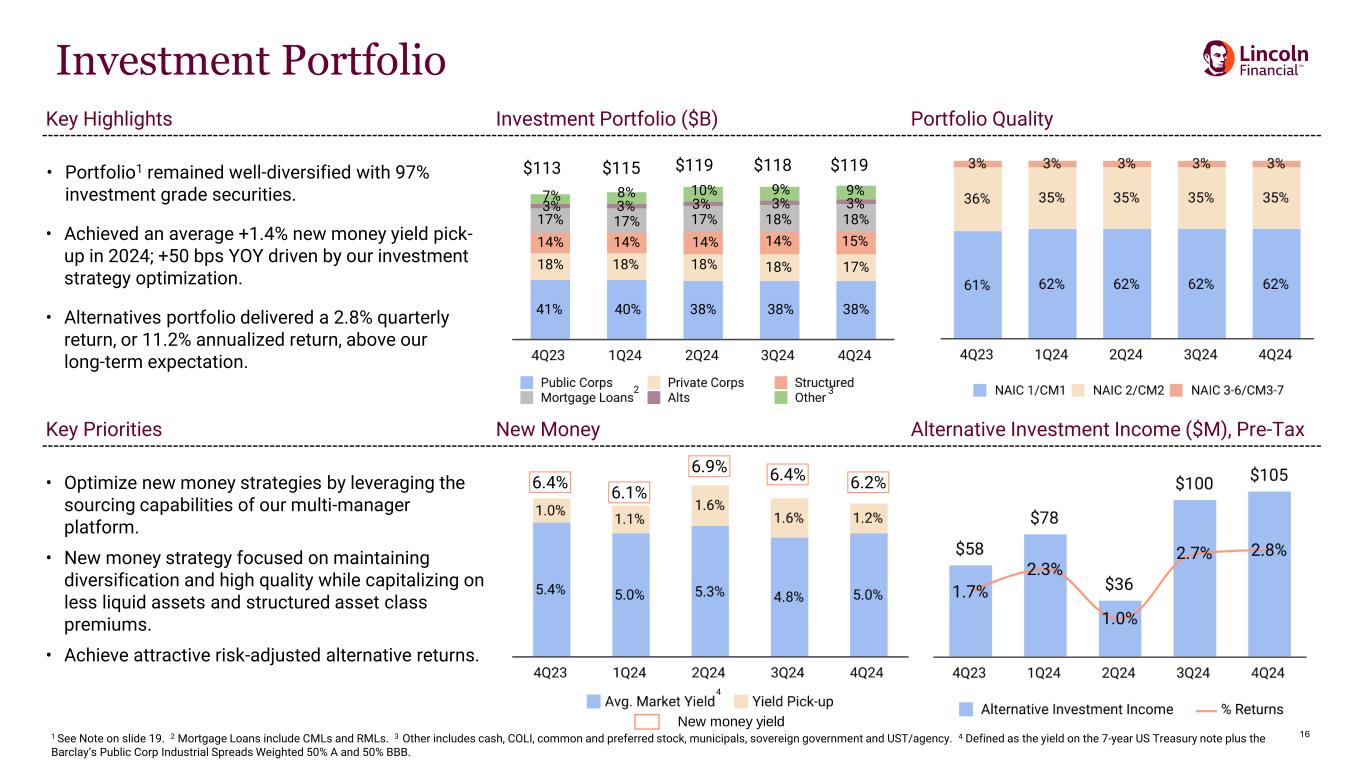
16 Key Highlights Investment Portfolio ($B) Portfolio Quality • Portfolio1 remained well-diversified with 97% investment grade securities. • Achieved an average +1.4% new money yield pick- up in 2024; +50 bps YOY driven by our investment strategy optimization. • Alternatives portfolio delivered a 2.8% quarterly return, or 11.2% annualized return, above our long-term expectation. Key Priorities New Money Alternative Investment Income ($M), Pre-Tax • Optimize new money strategies by leveraging the sourcing capabilities of our multi-manager platform. • New money strategy focused on maintaining diversification and high quality while capitalizing on less liquid assets and structured asset class premiums. • Achieve attractive risk-adjusted alternative returns. Investment Portfolio $113 $115 $119 $118 1 See Note on slide 19. 2 Mortgage Loans include CMLs and RMLs. 3 Other includes cash, COLI, common and preferred stock, municipals, sovereign government and UST/agency. 4 Defined as the yield on the 7-year US Treasury note plus the Barclay’s Public Corp Industrial Spreads Weighted 50% A and 50% BBB. $119 2 3 41% 40% 38% 38% 38% 17%18%18%18%18% 14% 14% 14% 14% 15% 18%18%17%17%17% 3% 3% 3% 3% 3% 9%9%10%8%7% 6.4% 6.1% 6.9% 6.4% 6.2% 4 New money yield
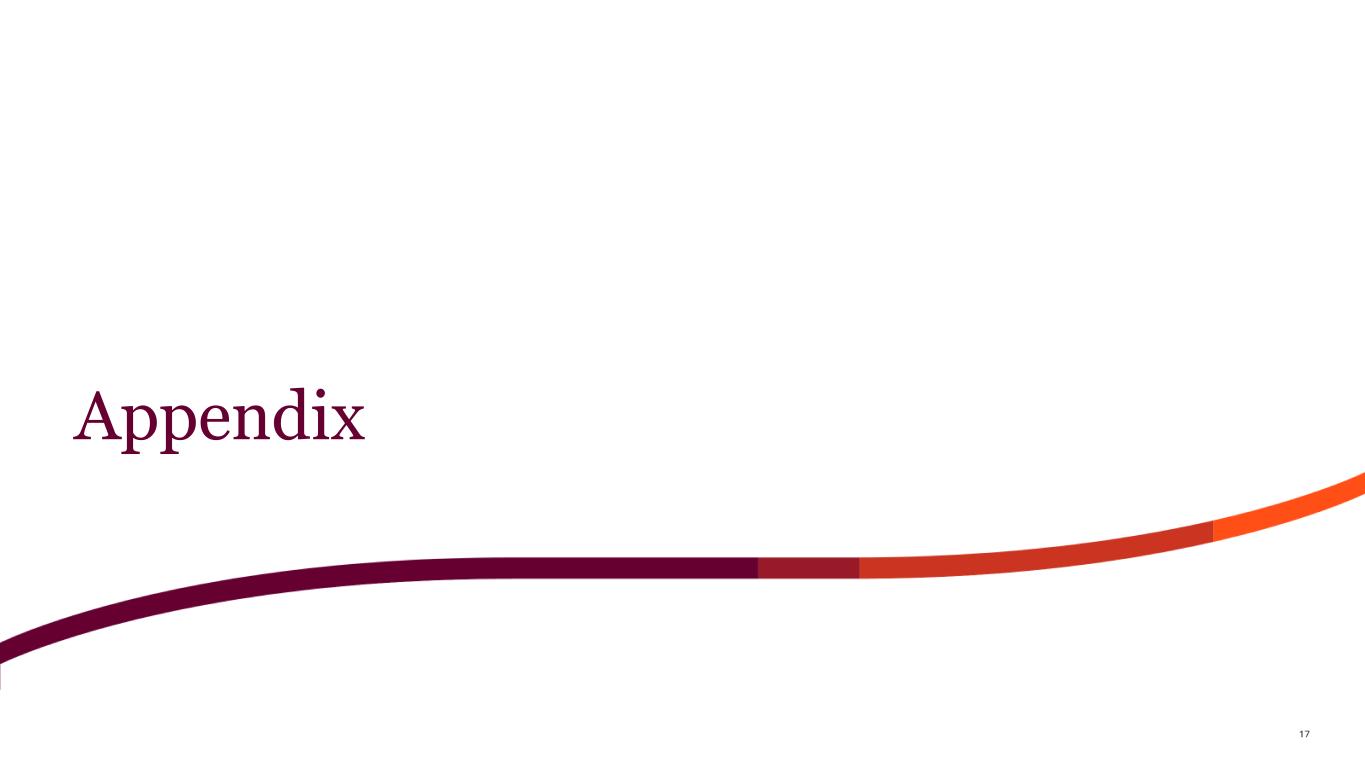
17 Appendix
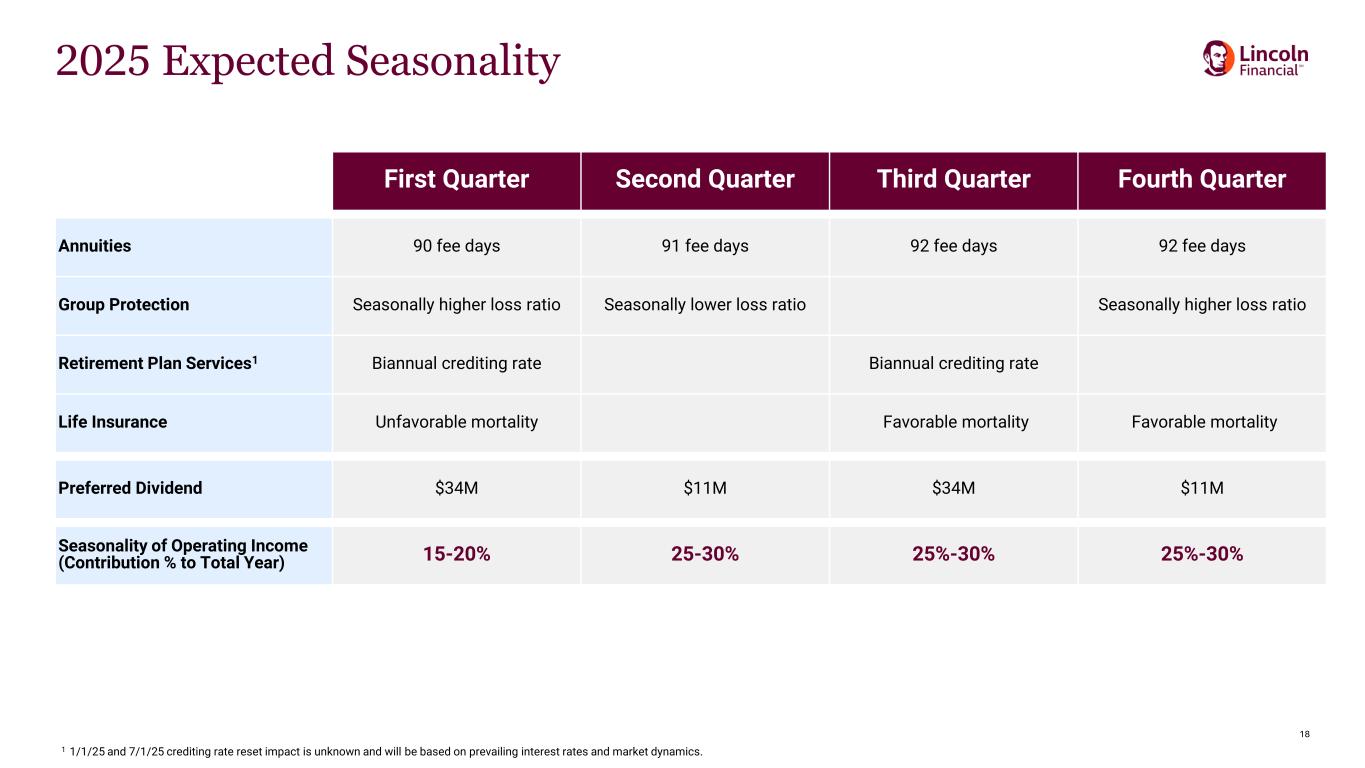
18 First Quarter Second Quarter Third Quarter Fourth Quarter Annuities 90 fee days 91 fee days 92 fee days 92 fee days Group Protection Seasonally higher loss ratio Seasonally lower loss ratio Seasonally higher loss ratio Retirement Plan Services1 Biannual crediting rate Biannual crediting rate Life Insurance Unfavorable mortality Favorable mortality Favorable mortality Preferred Dividend $34M $11M $34M $11M Seasonality of Operating Income (Contribution % to Total Year) 15-20% 25-30% 25%-30% 25%-30% 1 1/1/25 and 7/1/25 crediting rate reset impact is unknown and will be based on prevailing interest rates and market dynamics. 2025 Expected Seasonality

19 Investment Portfolio High quality and well-diversified portfolio1 The portfolio remains well-positioned • Long-term investment strategy is tightly aligned with our liability profile and positioned for various economic cycles. • 97% investment grade, the portfolio quality has increased, providing flexibility to further add incremental yield. • Well positioned to further optimize the portfolio asset allocation given high-quality asset mix and shift towards shorter duration liabilities. Portfolio allocation by asset class 1 Data on slide is as of December 31, 2024. 2 Other asset classes primarily include quasi-sovereign, cash/collateral, and UST/agency. Note: All information regarding LNC’s investment portfolio in this earnings supplement excludes assets related to certain modified coinsurance and coinsurance with funds withheld transactions. The modified coinsurance and funds withheld reinsurance agreements investment portfolio has counterparty protections in place including investment guidelines, as well as additional support including trusts and letters of credit that were established to meet LNC’s risk management objectives. $119B Average A Rated

20 Commercial mortgage loan portfolio Conservatively positioned CML portfolio1 Overall CML exposure • Disciplined portfolio construction delivering consistent loan performance. • Robust surveillance process (e.g. loan level financial review, rent roll analysis, stress testing, etc.). • Manageable near-term portfolio maturities in 2025 (3%), 2026 (6%) and 2027 (8%). – $15M2 average loan size across 2025- 2027 maturities. Office exposure • CML office loans 3% of total invested assets and well diversified by geography. • Limited maturities and conservatively positioned with average office loan size of $12 million2. – Maturities 2025-2026 = ~2% of our CML portfolio • 2025: $159 million with WA DSC 3.0x. • 2025: $195 million with WA DSC 1.9x. $17.4B Property types 1 Data on slide is as of December 31, 2024. 2 Excludes loans managed by non-LFG third-party managers and fully amortizing loans. 3 Includes CMLs in LP funds. 4 Lincoln Underwritten LTV is an internal estimate that considers the most recent financial reporting of each property and conservative cap rate assumptions. Portfolio LTV & DSC • Loan-to-values remain strong. • Strong debt service coverage reflecting recent property-level performance. • Diversified by property type, borrower, and geography. Portfolio Statistics Total CMLs Office Invested Asset % 15% 3% Avg Loan Size 2 $12M $17M Fixed Rate 100% 100% Remaining Term 8 Years 8 Years Debt Service Coverage 2.4x 2.3x Occupancy 93% 84% Credit Quality3 CM1 77% 81% CM2 22% 18% CM3-7 <1% <1% Property Type Book Value ($B) Debt Service Coverage Loan to Value (3rd Party Appraisal at Funding) Lincoln Underwritten Loan to Value4 Apartment $5.6 3.0x 44% 43% Industrial $5.10 2.2x 46% 50% Office $3.00 2.3x 44% 65% Retail $2.6 2.0x 46% 45% Other3 $0.9 2.4x 41% 43% Mixed Use $0.2 2.0x 47% 49% Portfolio $17.40 2.4x 45% 49%

21 Non-GAAP Financial Measures Appendix
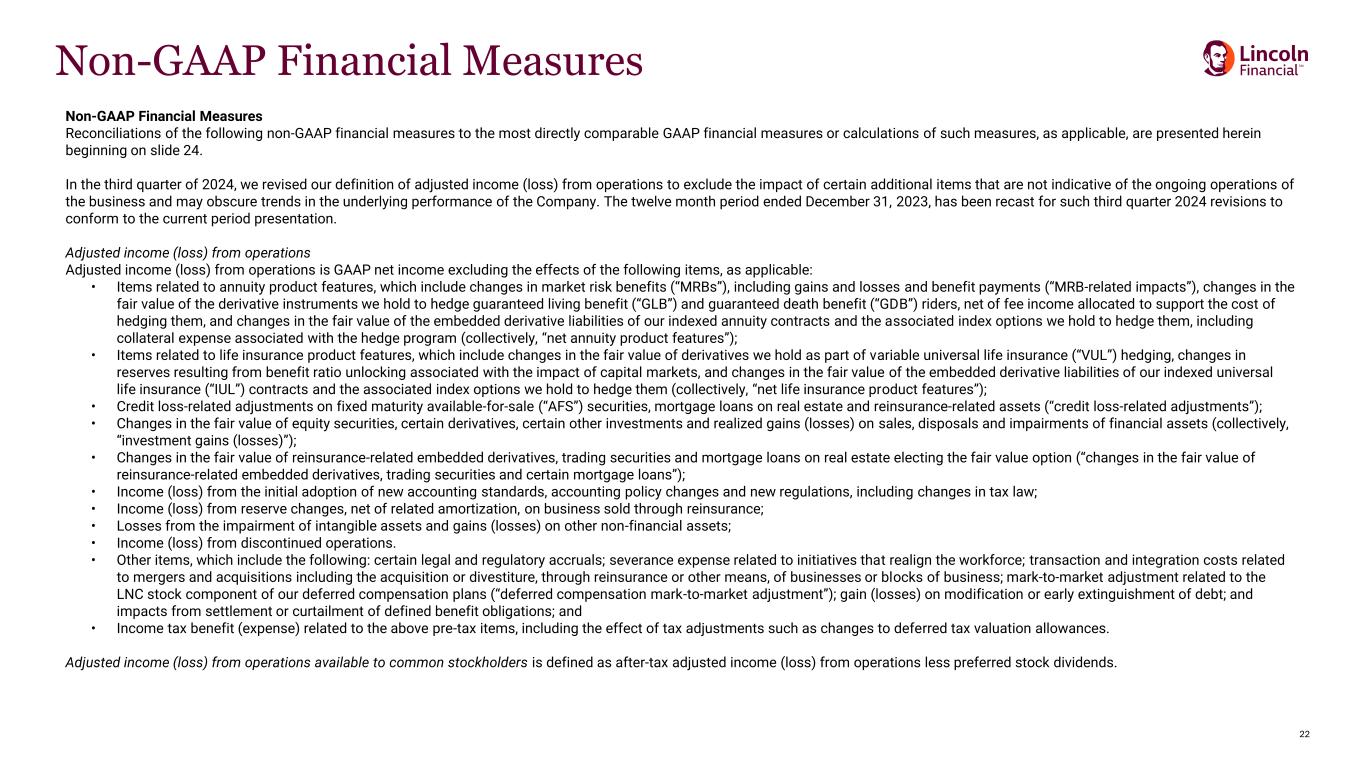
22 Non-GAAP Financial Measures Non-GAAP Financial Measures Reconciliations of the following non-GAAP financial measures to the most directly comparable GAAP financial measures or calculations of such measures, as applicable, are presented herein beginning on slide 24. In the third quarter of 2024, we revised our definition of adjusted income (loss) from operations to exclude the impact of certain additional items that are not indicative of the ongoing operations of the business and may obscure trends in the underlying performance of the Company. The twelve month period ended December 31, 2023, has been recast for such third quarter 2024 revisions to conform to the current period presentation. Adjusted income (loss) from operations Adjusted income (loss) from operations is GAAP net income excluding the effects of the following items, as applicable: • Items related to annuity product features, which include changes in market risk benefits (“MRBs”), including gains and losses and benefit payments (“MRB-related impacts”), changes in the fair value of the derivative instruments we hold to hedge guaranteed living benefit (“GLB”) and guaranteed death benefit (“GDB”) riders, net of fee income allocated to support the cost of hedging them, and changes in the fair value of the embedded derivative liabilities of our indexed annuity contracts and the associated index options we hold to hedge them, including collateral expense associated with the hedge program (collectively, “net annuity product features”); • Items related to life insurance product features, which include changes in the fair value of derivatives we hold as part of variable universal life insurance (“VUL”) hedging, changes in reserves resulting from benefit ratio unlocking associated with the impact of capital markets, and changes in the fair value of the embedded derivative liabilities of our indexed universal life insurance (“IUL”) contracts and the associated index options we hold to hedge them (collectively, “net life insurance product features”); • Credit loss-related adjustments on fixed maturity available-for-sale (“AFS”) securities, mortgage loans on real estate and reinsurance-related assets (“credit loss-related adjustments”); • Changes in the fair value of equity securities, certain derivatives, certain other investments and realized gains (losses) on sales, disposals and impairments of financial assets (collectively, “investment gains (losses)”); • Changes in the fair value of reinsurance-related embedded derivatives, trading securities and mortgage loans on real estate electing the fair value option (“changes in the fair value of reinsurance-related embedded derivatives, trading securities and certain mortgage loans”); • Income (loss) from the initial adoption of new accounting standards, accounting policy changes and new regulations, including changes in tax law; • Income (loss) from reserve changes, net of related amortization, on business sold through reinsurance; • Losses from the impairment of intangible assets and gains (losses) on other non-financial assets; • Income (loss) from discontinued operations. • Other items, which include the following: certain legal and regulatory accruals; severance expense related to initiatives that realign the workforce; transaction and integration costs related to mergers and acquisitions including the acquisition or divestiture, through reinsurance or other means, of businesses or blocks of business; mark-to-market adjustment related to the LNC stock component of our deferred compensation plans (“deferred compensation mark-to-market adjustment”); gain (losses) on modification or early extinguishment of debt; and impacts from settlement or curtailment of defined benefit obligations; and • Income tax benefit (expense) related to the above pre-tax items, including the effect of tax adjustments such as changes to deferred tax valuation allowances. Adjusted income (loss) from operations available to common stockholders is defined as after-tax adjusted income (loss) from operations less preferred stock dividends.
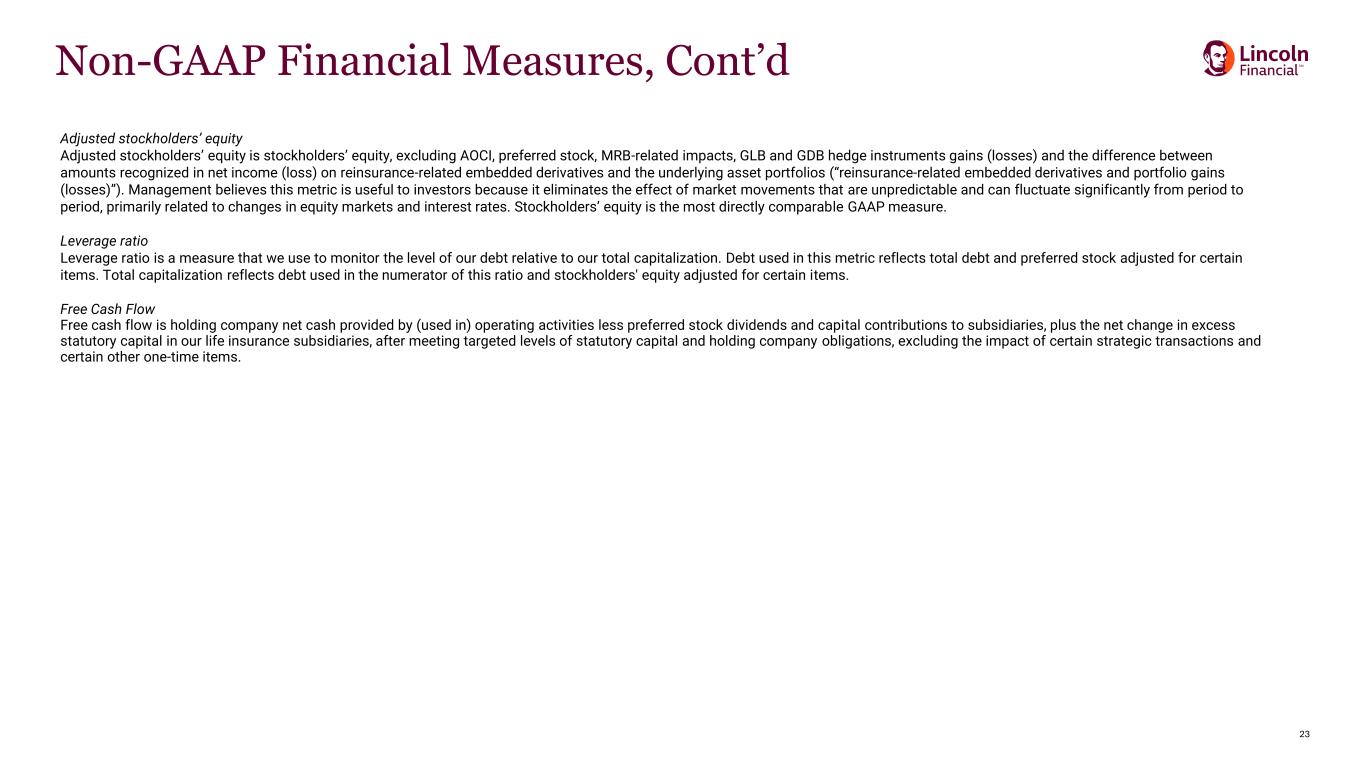
23 Non-GAAP Financial Measures, Cont’d Adjusted stockholders’ equity Adjusted stockholders’ equity is stockholders’ equity, excluding AOCI, preferred stock, MRB-related impacts, GLB and GDB hedge instruments gains (losses) and the difference between amounts recognized in net income (loss) on reinsurance-related embedded derivatives and the underlying asset portfolios (“reinsurance-related embedded derivatives and portfolio gains (losses)”). Management believes this metric is useful to investors because it eliminates the effect of market movements that are unpredictable and can fluctuate significantly from period to period, primarily related to changes in equity markets and interest rates. Stockholders’ equity is the most directly comparable GAAP measure. Leverage ratio Leverage ratio is a measure that we use to monitor the level of our debt relative to our total capitalization. Debt used in this metric reflects total debt and preferred stock adjusted for certain items. Total capitalization reflects debt used in the numerator of this ratio and stockholders' equity adjusted for certain items. Free Cash Flow Free cash flow is holding company net cash provided by (used in) operating activities less preferred stock dividends and capital contributions to subsidiaries, plus the net change in excess statutory capital in our life insurance subsidiaries, after meeting targeted levels of statutory capital and holding company obligations, excluding the impact of certain strategic transactions and certain other one-time items.

24 Reconciliation of Net Income Available to Common Stockholders to Adjusted Income from Operations Available to Common Stockholders Unaudited (millions of dollars, except per share data) For the Three Months Ended For the Twelve Months Ended 12/31/23 3/31/24 6/30/24 9/30/24 12/31/24 12/31/23 (1) 12/31/24 Net Income Net income (loss) available to common stockholders – diluted $ (1,246) $ 1,191 $ 884 $ (562) $ 1,675 $ (835) $ 3,187 Less: Preferred stock dividends declared (11) (34) (11) (34) (11) (82) (91) Adjustment for deferred units of LNC stock in our deferred compensation plans — 3 — — — (1) 3 Net income (loss) (1,235) 1,222 895 (528) 1,686 (752) 3,275 Less: Net annuity product features, pre-tax (1,008) 1,450 252 (381) 1,187 68 2,508 Net life insurance product features, pre-tax (225) (130) 4 (125) 46 (393) (207) Credit loss-related adjustments, pre-tax (27) (1) (34) (88) (28) (80) (152) Investment gains (losses), pre-tax (2) 167 (81) (230) (105) (67) (959) (483) Changes in the fair value of reinsurance-related embedded derivatives, trading securities and certain mortgage loans, pre-tax (3) (776) 194 201 (446) 587 (802) 535 Gains (losses) on other non-financial assets – sale of subsidiaries/businesses, pre-tax (4) — — 584 (2) — — 582 Other items, pre-tax (5)(6)(7)(8) (32) (186) (33) (19) (32) (55) (270) Income tax benefit (expense) related to the above pre-tax items 403 (268) (184) 246 (350) 479 (553) Total adjustments (1,498) 978 560 (920) 1,343 (1,742) 1,960 Adjusted income (loss) from operations 263 244 335 392 343 990 1,315 Add: Preferred stock dividends declared (11) (34) (11) (34) (11) (82) (91) Adjusted income (loss) from operations available to common stockholders $ 252 $ 210 $ 324 $ 358 $ 332 $ 908 $ 1,224 Earnings (Loss) Per Common Share – Diluted Net income (loss) 9.63 Adjusted income (loss) from operations (diluted) 1.91 Refer to following slide 25 for footnotes to table.
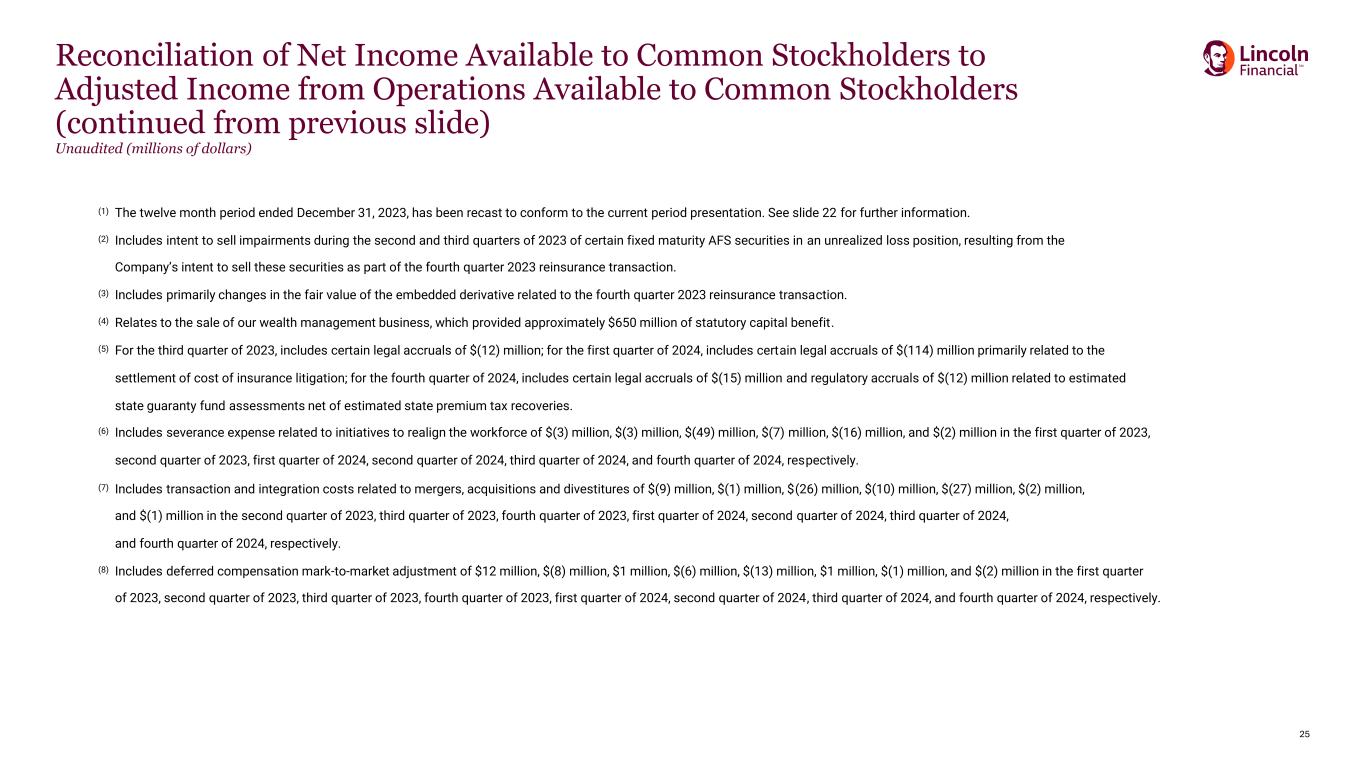
25 Reconciliation of Net Income Available to Common Stockholders to Adjusted Income from Operations Available to Common Stockholders (continued from previous slide) Unaudited (millions of dollars) (1) The twelve month period ended December 31, 2023, has been recast to conform to the current period presentation. See slide 22 for further information. (2) Includes intent to sell impairments during the second and third quarters of 2023 of certain fixed maturity AFS securities in an unrealized loss position, resulting from the Company’s intent to sell these securities as part of the fourth quarter 2023 reinsurance transaction. (3) Includes primarily changes in the fair value of the embedded derivative related to the fourth quarter 2023 reinsurance transaction. (4) Relates to the sale of our wealth management business, which provided approximately $650 million of statutory capital benefit. (5) For the third quarter of 2023, includes certain legal accruals of $(12) million; for the first quarter of 2024, includes certain legal accruals of $(114) million primarily related to the settlement of cost of insurance litigation; for the fourth quarter of 2024, includes certain legal accruals of $(15) million and regulatory accruals of $(12) million related to estimated state guaranty fund assessments net of estimated state premium tax recoveries. (6) Includes severance expense related to initiatives to realign the workforce of $(3) million, $(3) million, $(49) million, $(7) million, $(16) million, and $(2) million in the first quarter of 2023, second quarter of 2023, first quarter of 2024, second quarter of 2024, third quarter of 2024, and fourth quarter of 2024, respectively. (7) Includes transaction and integration costs related to mergers, acquisitions and divestitures of $(9) million, $(1) million, $(26) million, $(10) million, $(27) million, $(2) million, and $(1) million in the second quarter of 2023, third quarter of 2023, fourth quarter of 2023, first quarter of 2024, second quarter of 2024, third quarter of 2024, and fourth quarter of 2024, respectively. (8) Includes deferred compensation mark-to-market adjustment of $12 million, $(8) million, $1 million, $(6) million, $(13) million, $1 million, $(1) million, and $(2) million in the first quarter of 2023, second quarter of 2023, third quarter of 2023, fourth quarter of 2023, first quarter of 2024, second quarter of 2024, third quarter of 2024, and fourth quarter of 2024, respectively.
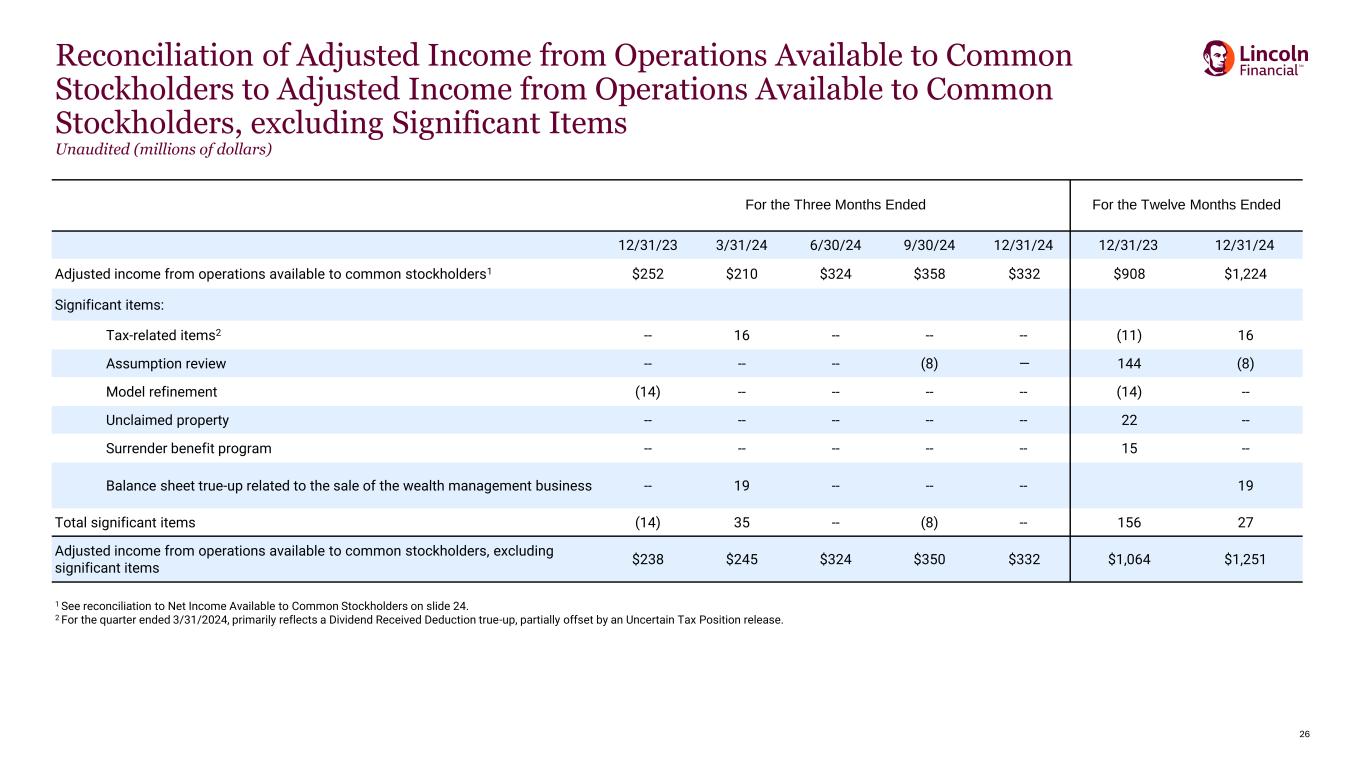
26 Reconciliation of Adjusted Income from Operations Available to Common Stockholders to Adjusted Income from Operations Available to Common Stockholders, excluding Significant Items Unaudited (millions of dollars) For the Three Months Ended For the Twelve Months Ended 12/31/23 3/31/24 6/30/24 9/30/24 12/31/24 12/31/23 12/31/24 Adjusted income from operations available to common stockholders1 $252 $210 $324 $358 $332 $908 $1,224 Significant items: Tax-related items2 -- 16 -- -- -- (11) 16 Assumption review -- -- -- (8) — 144 (8) Model refinement (14) -- -- -- -- (14) -- Unclaimed property -- -- -- -- -- 22 -- Surrender benefit program -- -- -- -- -- 15 -- Balance sheet true-up related to the sale of the wealth management business -- 19 -- -- -- 19 Total significant items (14) 35 -- (8) -- 156 27 Adjusted income from operations available to common stockholders, excluding significant items $238 $245 $324 $350 $332 $1,064 $1,251 1 See reconciliation to Net Income Available to Common Stockholders on slide 24. 2 For the quarter ended 3/31/2024, primarily reflects a Dividend Received Deduction true-up, partially offset by an Uncertain Tax Position release.
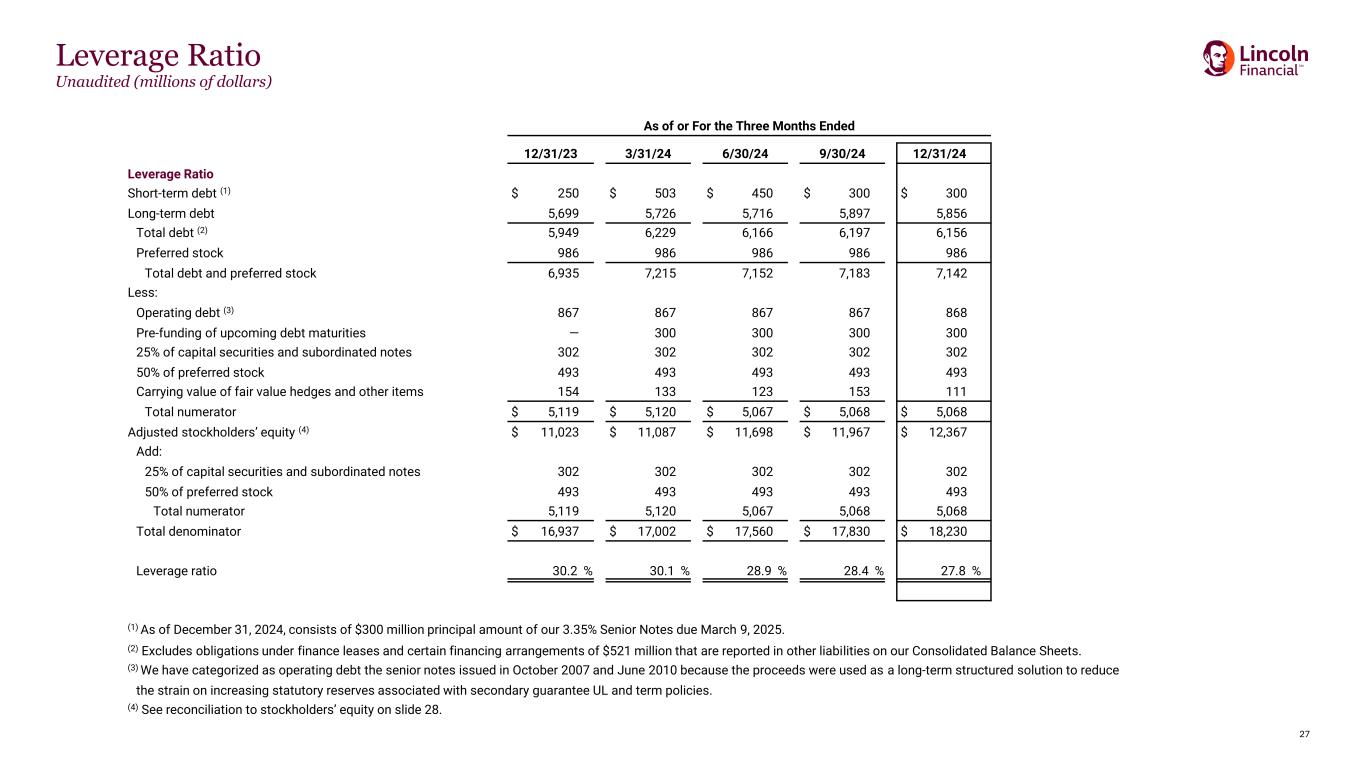
27 Leverage Ratio Unaudited (millions of dollars) As of or For the Three Months Ended 12/31/23 3/31/24 6/30/24 9/30/24 12/31/24 Leverage Ratio Short-term debt (1) $ 250 $ 503 $ 450 $ 300 $ 300 Long-term debt 5,699 5,726 5,716 5,897 5,856 Total debt (2) 5,949 6,229 6,166 6,197 6,156 Preferred stock 986 986 986 986 986 Total debt and preferred stock 6,935 7,215 7,152 7,183 7,142 Less: Operating debt (3) 867 867 867 867 868 Pre-funding of upcoming debt maturities — 300 300 300 300 25% of capital securities and subordinated notes 302 302 302 302 302 50% of preferred stock 493 493 493 493 493 Carrying value of fair value hedges and other items 154 133 123 153 111 Total numerator $ 5,119 $ 5,120 $ 5,067 $ 5,068 $ 5,068 Adjusted stockholders’ equity (4) $ 11,023 $ 11,087 $ 11,698 $ 11,967 $ 12,367 Add: 25% of capital securities and subordinated notes 302 302 302 302 302 50% of preferred stock 493 493 493 493 493 Total numerator 5,119 5,120 5,067 5,068 5,068 Total denominator $ 16,937 $ 17,002 $ 17,560 $ 17,830 $ 18,230 Leverage ratio 30.2 % 30.1 % 28.9 % 28.4 % 27.8 % (1) As of December 31, 2024, consists of $300 million principal amount of our 3.35% Senior Notes due March 9, 2025. (2) Excludes obligations under finance leases and certain financing arrangements of $521 million that are reported in other liabilities on our Consolidated Balance Sheets. (3) We have categorized as operating debt the senior notes issued in October 2007 and June 2010 because the proceeds were used as a long-term structured solution to reduce the strain on increasing statutory reserves associated with secondary guarantee UL and term policies. (4) See reconciliation to stockholders’ equity on slide 28.
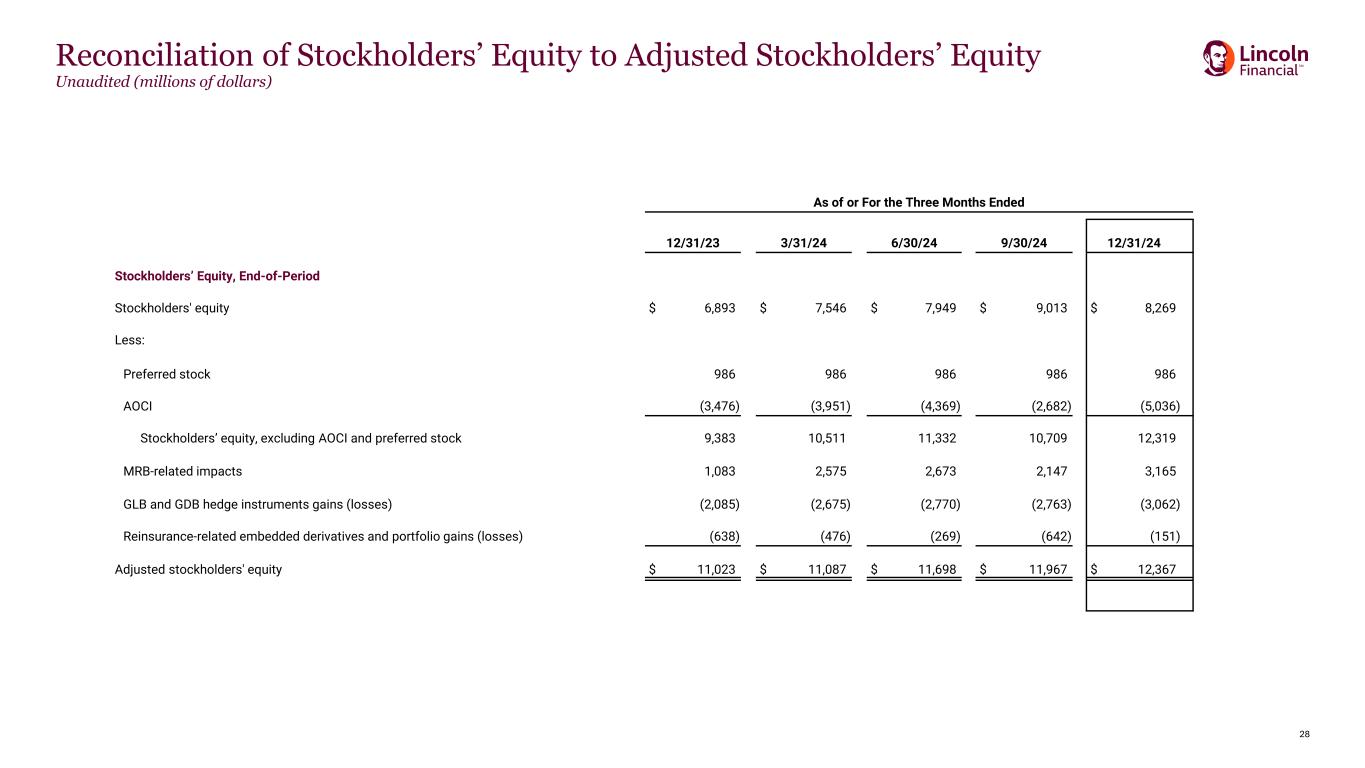
28 Reconciliation of Stockholders’ Equity to Adjusted Stockholders’ Equity Unaudited (millions of dollars) As of or For the Three Months Ended 12/31/23 3/31/24 6/30/24 9/30/24 12/31/24 Stockholders’ Equity, End-of-Period Stockholders' equity $ 6,893 $ 7,546 $ 7,949 $ 9,013 $ 8,269 Less: Preferred stock 986 986 986 986 986 AOCI (3,476) (3,951) (4,369) (2,682) (5,036) Stockholders’ equity, excluding AOCI and preferred stock 9,383 10,511 11,332 10,709 12,319 MRB-related impacts 1,083 2,575 2,673 2,147 3,165 GLB and GDB hedge instruments gains (losses) (2,085) (2,675) (2,770) (2,763) (3,062) Reinsurance-related embedded derivatives and portfolio gains (losses) (638) (476) (269) (642) (151) Adjusted stockholders' equity $ 11,023 $ 11,087 $ 11,698 $ 11,967 $ 12,367
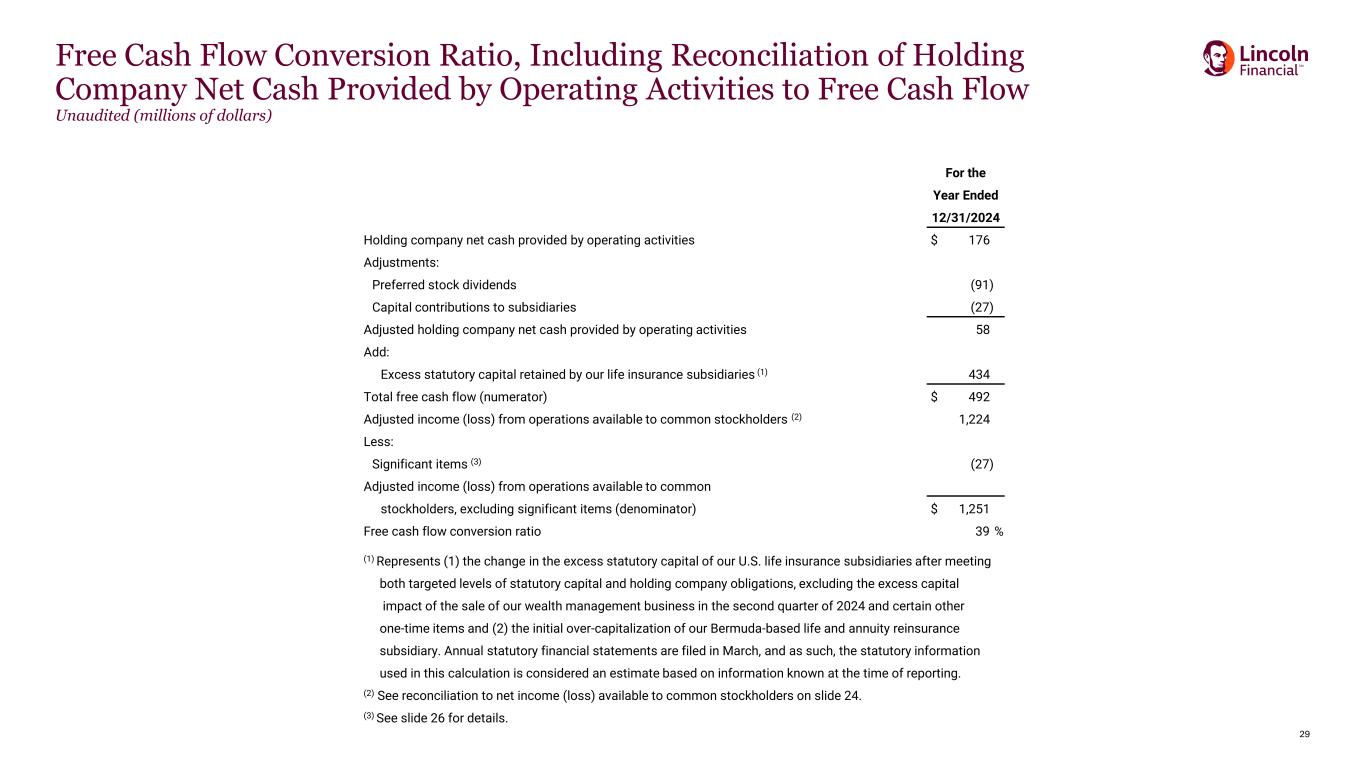
29 Free Cash Flow Conversion Ratio, Including Reconciliation of Holding Company Net Cash Provided by Operating Activities to Free Cash Flow Unaudited (millions of dollars) For the Year Ended 12/31/2024 Holding company net cash provided by operating activities $ 176 Adjustments: Preferred stock dividends (91) Capital contributions to subsidiaries (27) Adjusted holding company net cash provided by operating activities 58 Add: Excess statutory capital retained by our life insurance subsidiaries (1) 434 Total free cash flow (numerator) $ 492 Adjusted income (loss) from operations available to common stockholders (2) 1,224 Less: Significant items (3) (27) Adjusted income (loss) from operations available to common stockholders, excluding significant items (denominator) $ 1,251 Free cash flow conversion ratio 39 % (1) Represents (1) the change in the excess statutory capital of our U.S. life insurance subsidiaries after meeting both targeted levels of statutory capital and holding company obligations, excluding the excess capital impact of the sale of our wealth management business in the second quarter of 2024 and certain other one-time items and (2) the initial over-capitalization of our Bermuda-based life and annuity reinsurance subsidiary. Annual statutory financial statements are filed in March, and as such, the statutory information used in this calculation is considered an estimate based on information known at the time of reporting. (2) See reconciliation to net income (loss) available to common stockholders on slide 24. (3) See slide 26 for details.




























